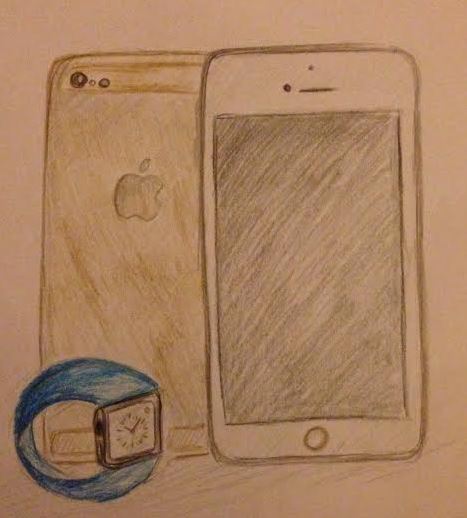Apple has yet to be dethroned.
With its sixth installment of the iPhone line, the tech king continues to offer “new” features. While it used to lead the smartphone industry, Apple is now scrambling to catch up with other offerings on the market from brands like Samsung and HTC.
Just like the year before, Apple released two editions of the iPhone, but these differ in size, not material. The 6 Plus display extends to 5.5 inches whereas the regular iPhone stands at 4.7 inches. In comparison, the iPad mini is merely 2.4 inches larger than the Plus. If Apple continues on this “phablet” sizing trend, in which iPhones grow steadily larger and iPads constantly smaller, we soon won’t be able to distinguish between them.
But Apple does plan on releasing a product deviating from its classic “i” lines, called the Apple Watch. Apple has always attempted to make its products “intimate” and “personal”—from the very first Macintosh in the 1980s to the i-[insert device name here] realm. Surprise, surprise, they claim the Apple Watch is their “most personal device yet.” Even though the iPhone 6 has hit stores already, the watch is set to come out in early 2015 in three ingeniously named collections: watch, watch sport and watch edition. Bridging the accessories – and tech – worlds, the watch features a touch screen face with quick access to apps commonly found on the iPhone. Although there is no keyboard, users will be able to utilize Siri to manage texts, mail, and other actions.
As far as aesthetics, the three versions of watches differ in style and material. The regular watch will come in stainless steel, the sport watch will be furnished with aluminum and the watch edition will feature gold embellishments.
Despite the seemingly enticing features, some aren’t buying into Apple’s watch. As Srinivas Mandyam ‘16 puts, “Smart watches have existed for years, notably those of Samsung and LG.” He continues sardonically, “The only significant innovation of the Apple Watch is the price tag.”
Unfortunately, due to the materials and Apple’s typical pricing scheme, the most basic watch (sport) is set to start at $350, costing nearly 75% more than the iPhone 6. For a screen about the size of an Oreo, the watch has a hefty cost. Not to mention, the watch cannot fully replace a smartphone. It requires a host iPhone to manage apps and other functions. By outsourcing a lot of actions to the phone, the timepiece would apparently have a longer battery life.
In addition to the iPhone modifications and watch launch, Apple has extended its tentacles into the mobile payment system world. No need for credit cards, since Apple Pay allows users to simply use the TouchID mechanism on their phone near a contactless reader. Its intent is to make payments more convenient and secure because the user will not need to disclose their credit or debit card information to cashiers.
Without a doubt, as the mobile payment system picks up speed, our transactions as a global economy will transform. On the other hand, the system that Apple Pay plans to use is far from groundbreaking, like the rest of its current offerings.
Sejal Waghray ‘15 asserts, “Although Apple Inc. has without a doubt changed the technology industry, evolved marketing strategies, and made its name in the domestic and global markets, I think they’ve started to fall behind a little bit. Google had introduced the Google Wallet and Samsung had introduced their smart watch, so Apple’s watch and payment system haven’t been ‘wow-factors’ like previous innovations because we’ve already seen them!” She concludes, “Their pre-established credibility and brand-name will probably carry them for now, but I’d say other companies are already threats, if not competition.”
As of now, Apple still maintains a hold on its tech dynasty, but its grip seems to be weakening.

